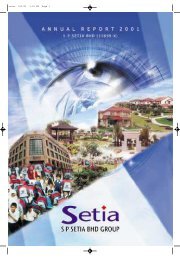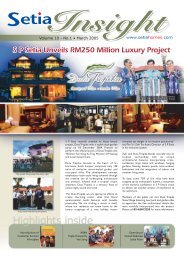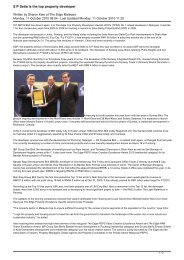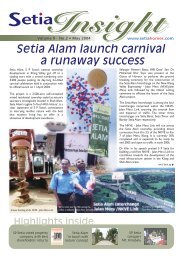Change - S P Setia Berhad
Change - S P Setia Berhad
Change - S P Setia Berhad
You also want an ePaper? Increase the reach of your titles
YUMPU automatically turns print PDFs into web optimized ePapers that Google loves.
90<br />
Annual report 2008<br />
NOTES TO THE FINANCIAL STATEMENTS<br />
FOR THE YEAR ENDED 31 OCTOBER 2008<br />
1. SIGNIFICANT ACCOUNTING POLICIES (cont’d)<br />
(n)<br />
Development properties (cont’d)<br />
Where the outcome of a development cannot be reasonably estimated, revenue is recognised to the extent of property<br />
development costs incurred that is probable will be recoverable, and the property development costs on the development<br />
units sold shall be recognised as an expense in the period in which they are incurred.<br />
When it is probable that total costs will exceed total revenue, the foreseeable loss is immediately recognised in the income<br />
statement irrespective of whether development work has commenced or not, or of the stage of completion of development<br />
activity, or of the amounts of profits expected to arise on other unrelated development projects.<br />
The excess of revenue recognised in the income statement over the billings to purchasers of properties is recognised as<br />
accrued billings under current assets.<br />
The excess of billings to purchasers of properties over revenue recognised in the income statement is recognised as<br />
progress billings under current liabilities.<br />
(o)<br />
Long term construction contracts<br />
The Group’s long term construction contracts are all fixed price contracts and where their outcome can be reasonably<br />
estimated, revenue is recognised on the percentage of completion method. The stage of completion is determined by the<br />
proportion that costs incurred to-date bear to estimated total costs, and for this purpose, only those costs that reflect actual<br />
contract work performed are included as costs incurred.<br />
Where the outcome of a long term construction contract cannot be reasonably estimated, revenue is recognised only to<br />
the extent of contract costs incurred that are expected to be recoverable. At the same time, all contract costs incurred are<br />
recognised as an expense in the period in which they are incurred.<br />
Costs that relate directly to a contract and which are incurred in securing the contract are also included as part of contract<br />
costs if they can be separately identified and measured reliably and it is probable that the contract will be obtained.<br />
When it is probable that total costs will exceed total revenue, the foreseeable loss is immediately recognised in the income<br />
statement irrespective of whether contract work has commenced or not, or of the stage of completion of contract activity,<br />
or of the amounts of profits expected to arise on other unrelated contracts.<br />
On the balance sheet, contracts in progress are reflected either as gross amounts due from or due to customers, where<br />
a gross amount due from customers is the surplus of (i) costs incurred plus profits recognised under the percentage of<br />
completion method over (ii) recognised foreseeable losses plus progress billings. A gross amount due to customers is the<br />
surplus of (ii) over (i).<br />
(p)<br />
Inventories<br />
Inventories are stated at the lower of cost and net realisable value. Cost is determined on the weighted average basis.<br />
In the case of finished goods and work-in-progress, cost comprises materials, direct labour, other direct charges and an<br />
appropriate proportion of factory overheads.<br />
In the case of completed houses held for sale, cost is determined based on specific identification method.<br />
Net realisable value represents the estimated selling price in the ordinary course of business, less selling and distribution<br />
costs and all other estimated cost to completion.

















